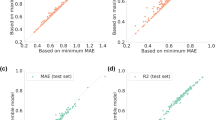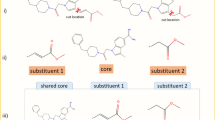Abstract
According to the similar property principle, structurally similar compounds exhibit very similar properties as well as similar biological activities. Many researchers have applied this principle to discover novel drugs, thereby leading to the emergence of the prediction of the activities of compounds based on their chemical structure, since the toxic or biological properties of compounds are determined by their chemical structure, particularly, their substructures. The concept of functional groups (FGs) of connected atoms (small molecules) determining the properties and reactivity of the parent molecule forms the cornerstone of organic chemistry, medicinal chemistry, toxicity assessments and QSAR. This study introduced a novel predictive system, i.e., a convolutional neural network that enables the prediction of molecular bioactivities using a novel molecular matrix representation. The number of atoms in small molecules were investigated to determine its accuracy during the prediction of the activities of the orphan compounds. This approach was applied to popular datasets and the performance of this system was compared with three other classical ML algorithms. All the experiments indicated that the proposed model was able to provide an interesting prediction rate (accuracy of 90.21).
Access this chapter
Tax calculation will be finalised at checkout
Purchases are for personal use only
Similar content being viewed by others
References
Ammar, A., Leclère, V., Jacques, P., Salim, N., Pupin, M.: Prediction of new bioactive molecules using a Bayesian belief network. J. Chem. Inf. Model. 54(1), 30–36 (2014)
Barakat, K.: Computer-aided drug design. J. Pharm. Care Heal. Syst. 1(4), 1–2 (2014)
Kothiwale, S., Borza, C., Pozzi, A., Meiler, J.: Quantitative structure–activity relationship modeling of kinase selectivity profiles. Molecules 22(9), 1–11 (2017)
Willett, P., Wilton, D., Hartzoulakis, B., Tang, R., Ford, J., Madge, D.: Prediction of ion channel activity using binary kernel discrimination. J. Chem. Inf. Model. 47(5), 1961–1966 (2007)
Chen, B., Mueller, C., Willett, P.: Evaluation of a Bayesian inference network for ligand-based virtual screening. J. Cheminform. 1(1), 1–10 (2009)
Xia, X., Maliski, E.G., Gallant, P., Rogers, D.: Classification of kinase inhibitors using a Bayesian model. J. Med. Chem. 47, 4463–4470 (2004)
Winkler, D., Burden, F.R.: Application of neural networks to large dataset QSAR, virtual screening, and library design. Methods Mol. Biol. 201, 325–367 (2002)
Kawai, K., Fujishima, S., Takahashi, Y.: Predictive activity profiling of drugs by topological-fragment-spectra-based support vector machines. J. Chem. Inf. Model. 48(6), 1152–1160 (2008)
LeCun, Y., Yoshua, B., Geoffrey, H.: Deep learning. Nature 521(7553), 436–444 (2015)
Bengio, Y.: Learning deep architectures for AI, vol. 2, no. 1. (2009)
Gatys, L. Ecker, A.S. Bethge, M.: A Neural algorithm of artistic style. arXiv Prepr., pp. 1–16 (2015)
Wang, H., Meghawat, A., Morency, L.P., Xing E.P.: Select-additive learning: improving cross-individual generalization in multimodal sentiment analysis, vol. 1 (2016)
Hentabli, H., Naomie, S., Saeed, F.: An activity prediction model using shape-based descriptor method. J. Teknol. 1, 1–8 (2016)
Feldman, H.J., Dumontier, M., Ling, S., Haider, N., Hogue, C.W.V.: CO: a chemical ontology for identification of functional groups and semantic comparison of small molecules. FEBS Lett. 579(21), 4685–4691 (2005)
Bobach, C., Böhme, T., Laube, U., Püschel, A., Weber, L.: Automated compound classification using a chemical ontology. J. Cheminform. 4(12), 1–12 (2012)
Mikolov, T., Sutskever, I., Chen, K., Corrado, G., Dean, J.: Distributed representations of words and phrases and their compositionality, pp. 1–9 (2013)
Bento, A.P.: The ChEMBL bioactivity database: an update. Nucleic Acids Res. 42(D1), D1083–D1090 (2014)
Lewis, R.A., Wood, D.: Modern 2D QSAR for drug discovery. Wiley Interdiscip. Rev. Comput. Mol. Sci. 4(6), 505–522 (2014)
Saeed, F., Salim, N.: Using soft consensus clustering for combining multiple clusterings of chemical structures. J. Teknol. Sci. Eng. 63(1), 9–11 (2013)
Hentabli, H., Saeed, F., Abdo, A., Salim, N.: A new graph-based molecular descriptor using the canonical representation of the molecule. Sci. World J. 2014 (2014)
Krizhevsky, A., Sutskever, I., Hinton, G.E.: ImageNet classification with deep convolutional neural networks. In: Advances in neural information processing systems, pp. 1–9 (2012)
Gupta, V.: Image classification using convolutional neural networks in keras (2017)
Witten, I.H., Frank, E., Hall, M.A., Pal, C.J.: Data Mining: Practical Machine Learning Tools and Techniques. Morgan Kaufmann, Burlington (2016)
John, G.H. Langley, P.: Estimating continuous distributions in Bayesian classifiers, pp. 338–345 (2013)
Chang, C.C.: LIBSVM: a library for support vector machines. ACM Trans. Intell. Syst. Technol. 2, 271–2727 (2011)
Bugmann, G.: Normalized Gaussian radial basis function networks. Neurocomputing 20(1–3), 97–110 (1998)
Bastien, F.: Theano: new features and speed improvements, pp. 1–10 (2012)
Chollet, F.: Keras documentation. Keras.Io (2015)
Acknowledgment
This work is supported by the Ministry of Higher Education (MOHE) and the Research Management Centre (RMC) at the Universiti Teknologi Malaysia (UTM) under the Research University Grant Category (VOT Q.J130000.2528.16H74 and R.J130000.7828.4F985).
Author information
Authors and Affiliations
Corresponding author
Editor information
Editors and Affiliations
Rights and permissions
Copyright information
© 2020 Springer Nature Switzerland AG
About this paper
Cite this paper
Hamza, H., Nasser, M., Salim, N., Saeed, F. (2020). Bioactivity Prediction Using Convolutional Neural Network. In: Saeed, F., Mohammed, F., Gazem, N. (eds) Emerging Trends in Intelligent Computing and Informatics. IRICT 2019. Advances in Intelligent Systems and Computing, vol 1073. Springer, Cham. https://doi.org/10.1007/978-3-030-33582-3_33
Download citation
DOI: https://doi.org/10.1007/978-3-030-33582-3_33
Published:
Publisher Name: Springer, Cham
Print ISBN: 978-3-030-33581-6
Online ISBN: 978-3-030-33582-3
eBook Packages: Intelligent Technologies and RoboticsIntelligent Technologies and Robotics (R0)




